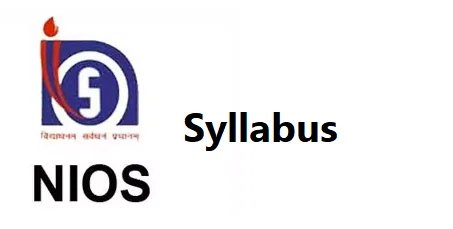NIOS Class 12 Accountancy Syllabus 2024-25

The accountancy syllabus for NIOS Class 12th students aims to enhance their knowledge of principles and practices of financial accounting. Accountancy is an important subject that opens many career and education opportunities after class 12th. It is a high scoring subject in which the students can score good marks if they prepare well. To start the preparation, it is crucial to know the latest NIOS Class 12 Accountancy syllabus 2024-25.
NIOS 12th Class Accountancy Syllabus 2024-25
The overall syllabus of accounts is comprised of 7 core modules along with 2 optional modules. The candidates have to choose any one of the two optional modules. Distribution of marks and teaching hours among various modules is given below.
| Core Modules | ||
| Name of Module | Maximum marks | Teaching Hours |
| Introduction to Financial Accounting | 6 | 17 |
| Accounting terms, Accounting equation and journal | 6 | 16 |
| Voucher approach in accounting | 12 | 40 |
| Bank reconciliation statement | 6 | 15 |
| Financial Statement | 15 | 30 |
| Partnership Accounts | 20 | 45 |
| Accounts for share capital | 15 | 52 |
| Total | 80 | 195 |
| Optional Modules | ||
| Analysis of Financial Statements | 20 | 45 |
| Final Accounts of Non-Trading Organization | ||
| Total | 100 | 240 |
NIOS Accountancy Syllabus of Class 12th in Detail
Check the detailed units and topics under various modules of accountancy subject as given below.
Core Modules
Module 1: Introduction to Financial Accounting
- Accounting-An Introduction
- Business transactions, Book-keeping, Accounting and its branches.
- Nature, functions and objectives of Financial Accounting
- Accounting Assumptions
- Meaning, Assumptions: Business Entity, Money Measurement, Going Concern and Periodicity.
- Accounting Concepts
- Meaning, concepts: Matching, Accrual, Realisation and Dual Aspect Concept.
- Accounting Conventions
- Meaning, Conventions: Consistency, Full disclosure, Materiality, Conservatism.
Module 2: Accounting Terms, Accounting Equation and Journal
- Accounting Terms
- Meaning and significance of different Accounting terms like Assets, Liabilities, Capital, Revenues and Expenses.
- Accounting Equation
- Need of Accounting equation, Meaning and preparation of Accounting equation.
- Rules of Accounting
- Meaning of Accounts, Type of Accounts: Assets, Liabilities, Capital, Revenue and Expense, Rules of Debit and Credit on the basis of Accounting Equation.
- Journal
- Meaning, classification of journal into General journal and special journals (with examples). Incorporation of journal entries involving different accounts.
- Cash Book
- Meaning, types-Simple Cash Book, Two column Cash Book and Three column Cash Book
Module 3: Voucher Approach in Accounting
- Vouchers and their preparation
- Meaning, usefulness and types of vouchers (Accounting Vouchers and Supporting Vouchers), preparation of Accounting Vouchers: Debit Voucher, Credit Voucher, Transfer Voucher.
- Day Book and Subsidiary Day Books
- Meaning Classification of Day Book: Simple Day Book, Day Book with a transfer column, Day Book with Bank and transfer column, Classification of Subsidiary Day Books: Purchases Day Book, Sales Day Book, Purchases Returns Day Book, Sales Returns Day Book.
- Recording the vouchers into Day Books
- Recording into Simple Day Book, Day Book with Transfer Column, Day-Book with Bank Column.
- Recording the Vouchers into Subsidiary Day Books
- Recording into Purchases Day Book, Sales Day Book, Sales Returns Day Book, Puchases Returns Day-Book.
- Ledger Posting of Day Book
- Meaning and format of Ledger, Posting the items from Day Book to Ledger A/cs.
- Posting of Subsidiary Day Books
- Posting the items from Subsidiary Day Books to Ledger A/cs.
- Trial Balance
- Meaning, objective and format of Trial Balance, Preparation of Trial Balance from Ledger balances.
- Errors and their Rectification
- Meaning of Accounting error, Classification of errors, Rectification of errors through journal and Accounting vouchers, Need and Preparation of Suspense A/c.
Module 4: Bank Reconciliation Statement
- Bank Reconciliation Statement
- Need, Meaning, reasons for difference between the balance of cash book and pass book, preparation.
Module 5: Financial Statements
- Capital and Revenue
- Classification of expenditure into Capital and Revenue (with examples), Calculation of Cost of Goods sold, Capital and Revenue receipts.
- Preparation of Trading and Profit and Loss Account and Balance Sheet.
- Need, format of Trading and Profit and Loss A/c., items to be recorded on the Debit and Credit Side of Trading and Profit and Loss A/c, Preparation of Trading and Profit and Loss A/c. Need, format of Balance Sheet, identification of Accounts to be written on liabilities and Assets side, Preparation of Balance sheet.
- Preparation of Trading and Profit and Loss A/c and Balance Sheet (with adjustments).
- Need for adjustments, adjustments regarding closing stock, Depreciation, Additional bad debts, Provision for Doubtful Debts, Outstanding expenses, Pre-paid expenses, Accrued income and unearned income, incorporation of Adjustments in Trading and Profit and Loss A/c and Balance Sheet
Module 6: Partnership Accounts
- Partnership-General
- Meaning, Partnership Deed, Types of Partners, Capital Accounts.
- Accounting Treatment of the following in the absence of Partnership Deed.
- Distribution of Profits
- Interest on Partner’s Loans
- Interest on Capital and Drawings
- Salary and Commission of Partner
- Admission of Partner
- Concept of Admission of Partner, Calculation of Profit sharing ratio, Revaluation of assets and liabilities, Goodwill: Meaning, Valuation and its recording, Adjustment regarding Adjustments in Partners’ capital A/c, Preparation of Revaluation A/c, Partner’s Capital A/c and Balance Sheet from the given information.
- Retirement and Death of a Partner
- Meaning, Calculation of New Profit sharing ratio, calculation of Gaining ratio, Recording of goodwill, Revaluation of assets and liabilities, Accumulated reserves and profits, Adjustments regarding partners, Capital Accounts, Calculation of profit upto the date of death of a partner. Preparation of Relevant A/cs and Balance Sheet.
- Dissolution of a Partnership Firm (Excluding Insolvency of Partners)
- Concept of Dissolution of partner and partnership firm, Realisation of asset and making payment of Liabilities, Treatment of unrecorded Assets and Liabilities, Preparation of Realisation A/c., Partner’s Capital A/c and Bank A/c.
Module 7: Accounting for Share Capital
- Joint Stock Company – An Introduction
- Meaning, characteristics and kinds of companies, Shares (as a source of finance) and its types, kinds of shares capital.
- Issue of Shares
- At par, At discount (Sec. 79) and At Premium (Sec, 78), Share Application, Share Allotment and Share Calls, Calls in Arrears and Calls-in-Advance. Journal entries in the books of company, Preparation of Accounting Vouchers, Preparation of Share Capital A/c, Share Allotment A/c, Bank A/c and Calls A/c.
- Forfeiture and Reissue of Forfeited Shares
- Meaning of forfeiture, Accounting Treatment for forfeiture of shares issued at Par, discount and Premium, Accounting Treatment for reissue of forfeited shares originally issued at par, discount and premium.
Optional Modules
Module 8: Analysis of Financial Statements
- Ratio Analysis – An Introduction
- Meaning of financial statements, Meaning and need for Analysis of financial statement. Arithmetical and Accounting Ratio, Concept of Ratio Analysis, parties interested in Analysis of financial statement, Significance of Accounting Ratios.
- Accounting Ratios – I
- Meaning, Significance and calculation of Liquidity and Turnover Ratios.
- Accounting Ratios – II
- Meaning, significance and calculation of Gross Profit, Net Profit, Return on Investment and Debt-Equity Ratios.
- Funds Flow Statement – I
- Meaning, Need, Increase/decrease in working capital by preparing Schedule of Changes in Working Capital, Funds from operation.
- Funds Flow Statement – II
- Preparation of Funds Flow Statement in ‘T’ form, Adjustments: Depreciation (including Provision for Depreciation), Sale and Purchase of fixed Asset.
Module 9: Final Accounts of Non-Trading Organisations
- Accounts of Non-Trading Organisations-I
- Meaning and characteristics, Receipts and Payments A/c; Meaning, Need, Preparation, Difference between Receipts and Payments A/c and Cash Book.
- Accounts of Non-Trading Organisations-II
- Income and Expenditure A/c: Meaning, Need, Preparation, Difference between Receipts and Payments A/c and Income and Expenditure A/c. Adjustments: Outstanding and Prepaid expenses, Accrued and unearned Incomes, Subscriptions and Depreciation on Asset only. Preparation of Balance Sheet.


